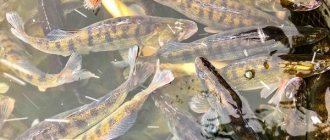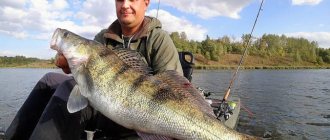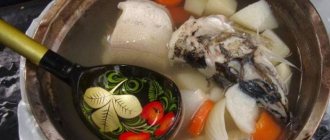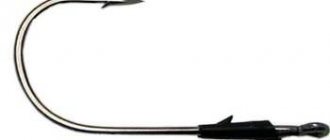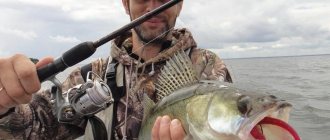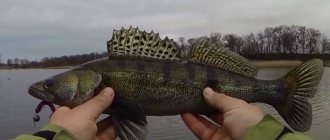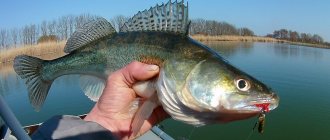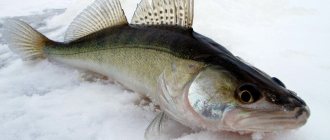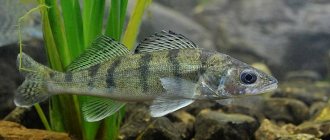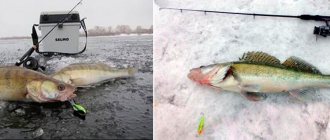Types of rigs for catching pike perch using sprat in winter
In winter, pike perch are caught using sprat in two main ways:
- On a fishing rod using heavy jigs, spinners, jig heads and bottom sinkers;
- On the girders;
Rod accessories
One of the most effective ways is to use heavy pike perch jigs; depending on the depth of fishing and the presence of current, their weight can range from 10 to 30 grams. The shape of the jig can be different; jigs in the form of a drop, a ball and a cone are most often used. Mormyshki can be used lead, copper, brass or other non-ferrous metals.
In terms of color, jigs that are black or dark green in color work best, but you need to have jigs of other colors with you. When fishing at great depths, as well as at night, it makes sense to cover the jig with a phosphor or apply a phosphorus drop.
In addition to jigs, you can use a spoon, a regular jig head, or an eared sinker.
Gear for catching pike perch using sprat in winter is made in two versions:
- With a retractable leash - the most catchy way:
- A triple swivel is tied onto the main line.
- To the swivel we tie a piece of fishing line 30-40 cm long, with a sinker attached to it (a jig, a spinner, a jig head with a hook).
- To the remaining free end of the swivel, attach a branch leash made of a fishing line of smaller diameter, 20-30 cm long with a hook or a light plastic jig.
- The sprat clings to the lower and upper hooks. Moreover, most often the pike perch attacks the sprat, which is planted precisely on the top hook, tied to a retractable leash, which plays the role of an irritant.
- If you have to frequently change bodies of water or fishing conditions, then it is easier to attach the sinker through a carabiner clasp in order to be able to quickly change it.
Can be installed without using a swivel. To do this, we make a loop on the fishing line 80 cm long, then cut it into uneven sections of 35 and 45 cm. We attach a hook to the short edge and a sinker to the long edge.
- One hook. With this setup, catching pike perch with sprat in winter is not so effective, but it also has many of its fans, especially since you can never know in advance what is on the fanged one’s mind.
There are two installation methods:
- When we use a jig, spoon, jig head. In this case, the sinker is attached to the main line directly or through a carabiner. A sprat is attached to the hook and you can fish.
- When we use a regular sinker, in this case a sinker is tied to the edge of the main fishing line, at a distance of 30-40 cm we attach a branch 20-30 cm long, onto which we attach a hook or a plastic jig.
Often fishermen string a piece of sprat on a regular spoon. In this case, the lure becomes more natural, and the predator is tempted not only by the play of the bait, but also by its smell. In addition, when attacking a spoon, the pike perch will not immediately recognize the trick and you will have time to make a normal hook.
Equipment for rigs
Catching pike perch in winter using sprat is very effective when using girders.
In most cases, fishermen use three main types of girders:
- On a flat base;
- Tripod;
- On the rail;
The most common and convenient, in my opinion, are considered to be girders on a flat base; I wrote about the advantages and disadvantages of these types of girders in the article catching pike perch with girders in winter .
The vents are equipped with a monofilament with a diameter of 0.25-0.4 mm. For medium-sized walleyes, 0.3 mm line is sufficient, but if you are hunting for trophy fangs, then you may need thicker monofilament. At the same time, it is always worth remembering that the more delicate the equipment, the more interest it arouses in the fish.
The amount of fishing line for one fishing line is selected based on the conditions that its length should be 10 meters greater than the depth at the fishing point, so that after the bite the pike perch has the opportunity to freely move to the side and taste the prey without feeling a catch.
The only thing where you shouldn’t give pike perch freedom is when fishing among snags, otherwise it will quickly hide among them and break the tackle.
The sinker is a sliding olive, its weight depends on the presence of a current, on average fishermen put olives of 7-10 grams, but on stagnant bodies of water their weight can decrease, and on the river, on the contrary, it becomes larger.
The leash is made of monofilament with a slightly thinner diameter than the main line. The length of the leash is 25-30 cm. A pellet is placed between the main load and the knot connecting the main line with the lead line.
A steel leash, as an element of gear for catching pike perch with sprat in winter, is used only in places where there is a high probability of a catfish bite, and it can significantly reduce the number of pike perch bites. A fluorocarbon leash of 0.35-0.45 mm would be a good compromise, and even if the pike bites it, it’s not so scary, since we will only lose live bait, and not an expensive spoon or jig.
Single hooks are better, No. 6-9 according to the domestic classification.
Gear equipment for catching pike perch with sprat in winter in still waters and on currents:
- Standing pond. A sinker is passed through the main line, then a leash with a hook is tied. A lead pellet is attached between the drive unit and the sinker.
- On the current. We take the edge of the main fishing line and knit a loop 1 meter long. Next, we cut it so that one edge is 30 cm long, and the other 70 cm. A sinker is attached to the short one, and a hook is attached to the long one.
Tulka in cooking
This small fish is widely used in cooking. It is useful for its relatively low calorie content (88 kcal), the presence of a large amount of Omega-3 polyunsaturated fats, amino acids, vitamins (in particular PP), iodine, fluorine, phosphorus, chlorine, calcium.
Thanks to everything, sprat meat is useful for those who have heart problems and suffer from atherosclerosis. Fish will help keep your nails, bones, and hair healthy for a long time. It helps normalize cholesterol in the blood.
Tulka is prepared in different ways. It is fried, stewed, boiled, dried, salted; Canned sprat can also be prepared at home. Of the latter, those made with the addition of tomato are especially good.
As a rule, sprat is eaten whole. This allows you to receive more calcium, which is found in its skin, tail, and bones. When frying or stewing, the latter soften so much that their eating is simply not noticed.
There are no contraindications for consuming sprat. Only those people who are allergic to everything that comes from the sea cannot eat it.
Recipes for sprat dishes
Sprat cutlets
This dish is easy to prepare. The sprat is defrosted (if you bought one), washed, cleaned (the insides and heads are removed. The rest is left. Then the carcasses are passed through a meat grinder.
A loaf of fish (pre-soaked in milk), spices, eggs, and salt are added to the resulting minced fish. Finely chopped onions wouldn't hurt. Mix everything and beat it.
Then they take some of the minced meat, form cutlets and fry them. The latter can be done. Immediately place the pieces on a hot frying pan. Most housewives first roll them in flour and breadcrumbs.
Pickled sprat recipe
This recipe is more complicated than the previous one, and you will need more additional ingredients. Among the latter, except, of course, the sprat itself, of which they take, for example, a kilogram, prepare: 6 tablespoons of vegetable oil, an onion, small carrots (2 pieces), garlic (3 cloves), half a glass of 9% table vinegar, half a glass of water , laurel (1 leaf). To prepare sprat you will need pepper and salt.
The sprat is marinated in the following sequence:
- prepare the marinade:
- peel garlic and onions; cut them coarsely;
- peel the carrots, cut them into circles;
- fill a large bowl with vinegar and oil; add chopped onions, carrots, garlic; pour in water; salt with two pinches of salt; they throw laurel and pepper; mix everything;
- place the bowl on the fire, heat to a boil;
— the kilns are cleaned, the entrails are removed, and the heads are separated; salt and leave for 2 hours. salt;
- after the fish are rinsed with water, placed in a glass or porcelain mold;
- pour the marinade prepared earlier and brought to a boil over the laid out sprat;
— in a day the sprat will be pickled.
Tackle for catching pike perch using sprat in winter
Fishing rod
We need a high-quality and powerful fishing rod 50-80 cm long with a hard carbon fiber whip and guide rings. The fishing rod handle should fit comfortably in the hand and be made of heat-saving materials such as wood or neopreon.
Coil
There are no special requirements, it all depends on the preferences of the fisherman. The simplest option is a large inertial reel with a friction brake, capable of holding about 35-40 meters of fishing line. A more expensive, but convenient option is a multiplier; you can also use small inertia-free reels with a spool size of about 1000 dai.
The most convenient, but at the same time expensive option for winter fishing is a multiplier reel; it is more convenient to use than a regular inertia reel with a friction clutch.
There are a number of fishermen who fish without using reels, fishing for prey exclusively with their hands; they put the simplest reels on the rod, which are needed only for winding and transporting the fishing line. True, in this case it is better to use a thicker fishing line, since you will be fishing without a clutch.
fishing line
Monofilament, the thickness depends on the size of the pike perch, 0.3 mm is considered the most optimal, for small pike perches 0.2-0.25 mm is enough, and for trophy pike perch, 0.35 mm may be needed. The thinner the line, the more effective it is to catch pike perch using sprat in winter, especially during the deep winter, but you should carefully calculate your strength and not over-fish.
Selecting a location
For a novice fisherman, it is often very difficult to decide on the location of the fanged robber, given its desire for extensive migrations. This behavior of the predator forces fishermen to drill many holes and reel in over 10 km in one day.
To find out as accurately as possible where the fishing object is, you need to know some of the subtleties of winter fishing:
- At the beginning of winter , more precisely in the first 2-3 weeks after the formation of ice, the degree of activity of the predator is characterized as high. It can be found at shallow depths and in autumn stopover areas.
- In the middle of winter , especially during the most severe frosts, prey descends to depth. There she spends a significant part of her time in the pits, coming out only in search of food.
- At the end of winter, the fish begin their pre-spawning glutton, therefore, the predator is active and bites on almost all offered baits. It chases fry and small fish, moving to areas where melt waters and streams flow. It is in such places that food for small fish accumulates.
It is recommended to look for promising fishing spots at:
- non-silted areas with a clean rocky surface;
- deep holes, especially filled with snags;
- edges, on the tops of which a predator climbs to feast on small fish;
- small hills, these places are more effective to fish at the beginning and end of winter;
- piles of pitfalls;
- in areas with weak currents;
- at the boundary between flow and standing water.
How to choose a sprat and place it on the hook correctly
Selecting sprat
Tulka is quite common in the Volga reservoirs and many fishermen prepare it in advance by catching it on a spider near hydraulic structures. You can also buy fresh or frozen sprat in the store.
Catching pike perch in winter will be most effective if you use sprat 4-5 cm long. When you get home, you need to package them in bags of 25-30 pieces and freeze them. They are defrosted directly on the pond, before fishing begins.
During the fishing process, sprat quickly loses its presentation, its color fades, and the tip of its tail breaks, which is why it has to be changed frequently. You need to take at least 50 fish with you to the pond, and if you go for the whole day and expect an active bite, then you may need 150-200 fish.
The remaining thawed sprat is not suitable for reuse and is thrown away.
How to properly hook
There are many different ways to put a sprat on a hook:
- One of the most effective ways is to insert the hook through the eye and out to the back area. The option of simply piercing the head through the eyes is quite unreliable, since the sprat is fragile and often flies off the hook, especially in intense currents.
- In still water bodies, the sprat is often attached to the back under the fin.
- Catching pike perch with sprat in winter can bring good results when, in addition to sprat, we additionally attach bloodworms to the hook.
- Some fishermen even string the sprat onto a hook, like a worm and nothing else, and you can catch it with that.
- During the deep winter period, pike perch may behave rather sluggishly and not want to attack a whole fish, but may well be tempted by pieces of it (head or tail).
Fishing Features
When hunting for pike perch using sprat, an angler gets the benefits of both artificial bait and natural bait. He does not need to select the color, size, brand of “rubber” or balancer, since the bait has the necessary aroma and looks natural.
You can fish this way with both fresh sprat and frozen sprat. In principle, there is not much difference. Many zander fishermen prepare bait in advance so that later they do not have to run around the shops looking for this fish. It is put into bags and stored in the freezer until fishing.
Instead of sprat, you can use other small fish. In particular, fishermen buy sprat or anchovy. You can prepare bait in open water by catching it in advance using a small bait. In this case, the fisherman will be able to attach roach, bleak or perch to the hook.
If the fry is very tight and you couldn’t get it out, then you can quite effectively put a piece of fish on the hook. This is no worse, but it is advisable to prepare fillet strips at home in advance so as not to waste time on the pond.
The principle of catching a fanged one with a sprat differs little from the classic vertical trolling:
- A sprat or other small fish is put on the hook of a jig head, heavy jig or helicopter.
- The weight of the load is selected based on the depth in the fishing zone and the strength of the current.
- The bait is lowered into the hole towards the bottom.
- Then the angler begins to make a retrieve, consisting of twitches and pauses, the duration of which is adjusted to the mood of the pike perch.
In fact, this is how they catch it with a vertical spoon, a balance beam, and other winter pike-perch lures. The difference, perhaps, is that the pause may be longer due to the edibility of the bait.
Photo 1. Tulka is a small fish of the herring family.
The advantages of fishing with sprat
This method, despite the fact that it is quite ancient, is rarely used by young fishermen. Today, newfangled balancers, Finnish vertical spinners and silicone baits are more in use. But fishing with sprat also has its advantages:
- simplicity of the method;
- cheap bait, no need to purchase expensive baits for vertical fishing;
- versatility;
- catchability.
Fishing this way allows you to catch pike perch at any time of winter. In the dead of winter, many baits do not show the expected results, but not sprat. The passive fanged fish responds superbly to the offered bait. Moreover, he takes it confidently, which is not typical of this time.
Catching pike perch with sprat in winter - fishing techniques and tactics
In winter, pike perch behaves very sluggishly and practically does not move around the reservoir. Now our task is to find promising areas and fish them. So we will have to walk a lot and drill a large number of holes, regardless of what equipment we use for catching pike perch with sprat in the winter (rod or girder)
It is advisable to initially study the bottom topography using a map, tips from the guard of the reservoir, and also an echo sounder.
The easiest way would be to sail a boat with an echo sounder in late autumn and enter data about promising areas into the navigator, or remember landmarks on the shore.
Fishing technique with a fishing rod:
- Having found an interesting area, we drill about ten to fifteen holes at a distance of 5-10 m from each other and begin fishing.
- We lower the rig with bait to the bottom;
- Raise it to a height of 20-30 cm when fishing in medium and strong currents and 40-50 cm in standing and low-flowing reservoirs;
- At this depth, we begin the game, making smooth rises with the fishing rod up to a height of 20-40 cm, alternating them with pauses. The length of pauses can be from several seconds to 1 minute. The more intense the bite, the shorter the pause and vice versa. Everything is the same as when catching pike perch in winter with a spoon .
- From time to time, instead of going up, you can lightly play with the fish in one place.
There are days when the pike perch behaves too passively and does not want to attack moving targets, so after drilling a series of holes, it is necessary to install two or three fishing rods with the expectation that the pike perch can bite on a non-moving bait. At the same time, we fish the remaining holes in parallel using the above method.
At the end of winter, fishing for pike perch using sprat can take place in different layers of water. The fact is that with warming, small fish become more active, in search of which the pike perch rises to the surface.
When fishing in the current, it is periodically worth giving the opportunity for the current to drag our bait a little, thereby covering a large area of water.
If one of the holes works, then the rod must be quickly re-equipped with a new sprat, since the pike perch stays in schools and there is a high probability of another bite from the catfish. Then, maintaining silence, drill several additional holes around the triggered hole at a distance of up to 1 meter.
Jerky fishing for pike perch using sprat in winter
At promising points, the girders can be placed in a checkerboard pattern or along a curved line. Arranging them along a curved line, we place the first girder at the beginning of the descent, and the subsequent ones as they deepen, so as to fish the entire slope. The piers are placed at intervals of 10-15 meters, so if the length of the slope is short, then we place one at the beginning, another in the middle and a third at the lowest point, making several rows.
Usually a fisherman needs 10 poles for normal fishing, but avid fishermen can take 20-30 poles with them.
On a standing reservoir , the rig is loaded as follows: we wait until the equipment reaches the bottom, then we raise it to a height of 20-50 cm and fix the fishing line on the reel. Here it is necessary to take into account the size of the leash and set the depth so that the sprat is at a distance of 5-15 cm above the bottom level. Then we reel out the tackle, hook the sprat onto the hook, lower it back and insert a signal flag into the groove of the reel.
When fishing in current conditions , we immediately place the sprat on the hook and lower it to the bottom, remove the slack in the fishing line and fix the signal flag.
A straightened flag signals the activation of the vent. In this case, we approach it with maximum caution and without making unnecessary noise. There is no need to rush, especially since the pike perch needs to be given about a minute so that it swallows the bait normally and then we hook it.
A functioning vent must be re-equipped as soon as possible, and several additional holes must be made nearby and vents installed on them.
Gear device
It is known that pike perch has a bony, hard mouth that is not so easy to reliably cut through, even with sharp hooks. In addition, the fish is of decent size and, when caught, behaves assertively and powerfully. This must be taken into account when choosing gear for winter fishing for fanged:
- The fishing rod chosen is hard, capable of making a sharp, sharp hook and at the same time extinguishing the first jerks of a weighty fish. Its length is about 60–90 cm. With such a fishing rod it is easy to carry out retrieving and you can spot pike perch without any problems.
- The fishing line, and in winter fishing nylon is preferable, is chosen with a diameter of 0.25–0.30 mm. Its strength indicators must be at least 3 kg.
- The reel used is lightweight and made of plastic with a smooth motion. In fact, it is only needed for storing fishing line and for reeling it in during long walks from one pike perch point to another.
You don't have to use a leash. If there is a possibility that a pike will grab, then you can use a short steel twist to minimize the cut, not to lose the trophy and not to injure the fish.
Photo 2. One of the methods of baiting.
Where to catch pike perch using sprat in winter
First of all, pike perch that live in the reservoirs of the Volga basin, where this fish is its natural food source, is used to catch pike perch. Practice has shown that in many reservoirs where it is not found in natural conditions, pike perch still eagerly attacks this bait.
Pike perch can be successfully caught using sprat throughout the winter. During the deep winter period, such bait often turns out to be more catchy than spinners and balancers, since very often the pike perch is so passive that the play of artificial baits even scares it away, but the fish or its pieces have a natural appearance and smell that can make the fanged one stir up.
First of all, you should look for pike perch at a depth of about 15 m; they often choose deeper areas. In shallow water, you can hardly find it; the minimum search depth is 4 meters.
Here you should look for bottom anomalies and significant differences in depth, such as:
- A single snag or a cluster of them;
- Placers of boulders and stones;
- Locations close to hydraulic structures;
- Gentle slope in depth with tracks;
- Old river beds, flooded areas of forests, groves or buildings (on reservoirs);
- Colonies of shells;
- Shoals (heels) between deep-water areas;
Pike perch does not welcome soft and muddy bottoms, preferring hard rocky and sandy areas.
How to catch
Fishing tactics in winter are carried out according to the following scheme:
- drill about 10 holes;
- fish the holes, lowering the bait 25-50 cm from the bottom (depending on the current);
- use a retractable leash to attract the attention of fish.
But the technique of fishing with a fishing rod, jig, girders and hookers will be somewhat different.
How to fish with baits and girders
It is necessary to install the tackle correctly:
- place the sprat on the hook;
- lower the reel until the load touches the bottom;
- pull the line, raising the bait by 20-30 cm;
- fix the reel with a flag at the vent or tie the spacer to the coastal vegetation.
When a bite occurs, you need to wait about 30 seconds for the pike perch to swallow the bait, then hook. Quickly pull out the tackle, reload and lower it into the water. As long as a school of predators stays nearby, you can catch several fish in a row.
Video: how to make supplies for catching pike perch
How to fish with a rod and jig
Catching tactics for fishing rod and jig are as follows:
- the bait is lowered to the bottom;
- make a sharp jerk, lifting the bait;
- alternate jerks with pauses of up to 15-20 seconds.
If you are fishing in a body of water with standing water, then you should fish different horizons.
What gear is used for fishing?
There are only three main winter gear for pike perch, but each of them has its own modifications depending on the local habits of anglers. The following fishing rods are in use:
- spinner;
- jig supply;
- zherlitsa.
Below we will describe in more detail each of them and the fishing method used.
Flashing is the main method
Ice fishing is the name given to catching a predator using artificial bait using various animations, something like spinning in a vertical plane. Not only vertical spinners are used as bait, but also other products:
- balancers;
- amphipods;
- Ratlin wobblers.
In winter lures, two types of lures are used:
- narrow-bodied vertical vibrators;
- tube spoons with beveled cuts.
Balancers
The balancer, unlike the spinner, is a horizontal bait. It is a metal fish equipped with soldered single hooks at the front and back and a hanging tee at the bottom of the belly.
In addition, the balancer has plastic wings closer to the back of the body, thanks to which the artificial fish gets a kind of play. When retrieving, the bait describes a trajectory close to a figure eight horizontally, while oscillating in the vertical plane.
To the rattlins
The Rattlin is a bladeless wobbler with an attachment point at the top. The ring for this is located approximately in the center of gravity on the back. The nose of the artificial fish is narrowed, which gives it the opportunity to perform unique, attractive movements during animation.
What does a winter fishing rod look like for pike perch?
For trolling I use a special fishing rod up to one meter long. Modern models have a reel seat and guide rings.
The fishing rod can be supplied in either a plug-in or telescopic version. In the first option, it is possible to equip with replaceable tips similar to feeder ones. This allows you to use the rod to catch not only hard-mouthed pike perch, but also softer-mouthed perch or trout.
The reel used is a spinning or multiplier reel with a size of 1000 units according to Shimano-Daiwa. The use of modern mechanisms allows you to fish out a predator not only by the fishing line, but also, by loading the friction brake, reduces the risk of the gear breaking.
The reel is equipped with a monofilament line with such tensile strength that it is possible to pull out a trophy pike perch weighing up to five kilograms. Unfortunately, nowadays you rarely see a larger specimen. Nylons with a diameter of 0.25 millimeters or more can withstand this load. At the same time, you need to remember that on a thick fishing line, a light bait will sink more slowly and work worse.
On the jig
You can catch pike perch with a jig using both natural bait and artificial bait. The following baits are used on the hook:
- bunch of bloodworms;
- worms;
- fish slices;
- small frozen sprat;
- live fry.
The most commonly used artificial additives are:
- “edible” silicone;
- foam rubber impregnated with attractants;
- beads, rings, edges.
The fishing rod for jig fishing is equipped with a bright nod, which is noticeable from a great distance. The diameter of the fishing line is chosen to be the same as on the lure – 0.25-0.30 millimeters.
What does a pike perch jig look like?
The pike jig differs from the model we are used to in its greater weight and size. Its main purpose is to quickly deliver the bait to great depths and keep the equipment in the river flow. Therefore, sometimes a large jig head plays its role.
Pike perch are caught with jig tackle in different ways. With the passive method, tackle is used, which also includes an additional hook, hung 30-50 centimeters above the end jig. In this case, you can equip the fishing rod with two different baits.
Usually a fry is baited onto the top hook, which attracts a predator with its movement, so there is no need to animate the tackle with your hands. This option is best used on a small current, when the water flow adds its contribution to the game of the rig.
Active fishing involves playing with bait. In this case the following is performed:
- tapping on the bottom;
- rise with varying intensity of vibrations;
- pauses of varying lengths;
- jerks and stops.
Zherlitsy
Zherlitsy are usually placed in a selected area around the main fishing spot: with lures or jigs. The following fish are used as live bait:
- crucian carp;
- roach;
- Yeltsov;
- minnows;
- bleak;
- top melter.
Equipment for fishing in still water and in currents differs. In the first case, the sliding sinker is attached above the leash. On the river, a paternoster-type installation is used, when the sinker lies on the bottom, and the live bait is raised a little higher on a branch leash.
Playing technique
It is worth considering that fish activity in winter is much lower than in the warm season. Pike perch rarely moves, metabolic processes in the organisms slow down, and much less food is needed to satiate them.
To activate the bite, you can try using an irritating technique:
- we lower the fishing line to the very bottom, then smoothly raise it to a height of 40-50 centimeters from the bottom;
- hold the bait in this position for 5-6 seconds;
- We sharply drop the line to the bottom.
Such a game will activate the bait, causing it to move and attract the attention of a predator.
The main thing when catching pike perch is to avoid too frequent and sudden movements; such behavior of the bait will only scare away the predator.
Blitz tips
- To maximize the number of bites , you can use an effective method - painting the jig head with a phosphor that is illuminated in the water surface. This glow perfectly attracts a predator living at great depths.
- to achieve a good catch in a frozen reservoir if you carry out a constant and detailed analysis of the process. You should skillfully secure the bait, skillfully feed it and control every movement of the baitfish under water. Compliance with these conditions will greatly enrich the total mass of the catch.
- It is recommended to carry out hooking quite sharply so that the sting of the hook has the opportunity to penetrate as deeply as possible.
- A necessary attribute of winter fishing is a hook , which is capable of providing all possible assistance when pulling predatory fish onto the ice.
- It is impossible to predict what kind of game a pike perch will play on a particular body of water , so you should try a variety of options, then the likelihood of a bite will increase significantly.
Source: lakeking.ru
How to put a sprat on a hook
